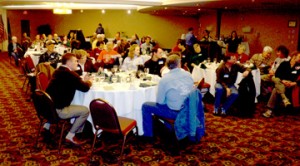 Last night I attended (well, presided over) the 2010 Annual Meeting of the Coos Curry Small Woodlands Association Annual Meeting and Dinner. This was my second year as President at the meeting. We had about 50 people in attendance. The meeting went quickly and we even got a long motion by the Scholarship Committee dealt with (approved with one amendment). All the experience I had presiding over the meetings of the Handcrafted Soapmakers Guild came in very handy!
Last night I attended (well, presided over) the 2010 Annual Meeting of the Coos Curry Small Woodlands Association Annual Meeting and Dinner. This was my second year as President at the meeting. We had about 50 people in attendance. The meeting went quickly and we even got a long motion by the Scholarship Committee dealt with (approved with one amendment). All the experience I had presiding over the meetings of the Handcrafted Soapmakers Guild came in very handy!
Gary Haga, a local logger and entrepreneur, was one of the speakers. His topic was Economically Utilizing Biomass (What to do with those slash piles?). I found it VERY interesting.
When logging is done, the loggers take the “merchantable timber” to the mills, which leaves everything that isn’t a log there on the landing – and that includes limbs, tops, bottoms, rotten trees … anything that isn’t a solid log suitable for sawing into boards at the specs of the particular mill(s) being delivered to. Some of the residual can sometimes be taken for chips, but even so, that needs to be clean and able to be loaded onto trucks. However you look at it, there is LOTS of stuff left over (90,000 tons in 2009 in Coos County alone).
Last year I asked the loggers to leave anything that could be firewood separately stacked, but their definition of “useable for firewood” was considerably different than mine … and we still had a huge pile. I hate the slash piles, but figuring out what to do with them has been problematic (not just for us, apparently). It just seems like all that wood could be used for something!
From the piles from last year we’ve been picking out firewood and let others do the same. We also went up and chipped some of the branches and such to put on the space between the raised beds in our garden. That was a LOT of work (but the parts of the garden that got done did look very “Martha Stewart”!). Even so, we hardly made a dent into the piles.
A couple of years ago I got the idea that maybe they could be chipped and then turned into pellets or something that could be used in woodstoves. Like Presto Logs or something. I even did some research on it, and come to the conclusion that it would take financing and expertise far above what I have. Turns out, that’s exactly what Gary Haga’s talk was about last night.
Gary has been doing research into the possibilities of making hog fuel (dirty chips that can be burned in large burners to provide heat and/or energy) and also into making pressed blocks or pucks that can be burned like logs in a woodstove. So far he hasn’t found an economical way to do it. The chips have to be dried and pressed … and the machines that do that run upwards of $500,000. There is also the issue of getting the equipment to piles, which are usually on log landings at the end of bumpy, rutted, dirt and gravel logging roads. All in all, it’s not feasible YET – but he’s still working on it.
In the meantime, I’m still trying to figure out what we can do here. This year we’re going to have some more logging done and I’m going to be even more specific on how I want the slash separated and piled. Hopefully we can figure out something we can do here that will utilize at least part of it more efficiently.
In the long term, it will take the establishment of a co-generation facility being built in Coos County that can utilize the potential fuel to generate energy. There are research and feasibility studies being done, but it will probably be quite a while before anything is actually realized. I just hope it’s in time help the timber industry and economy here locally.




Leave a Reply